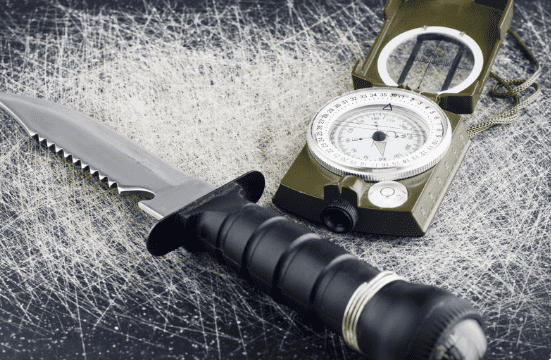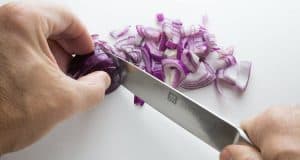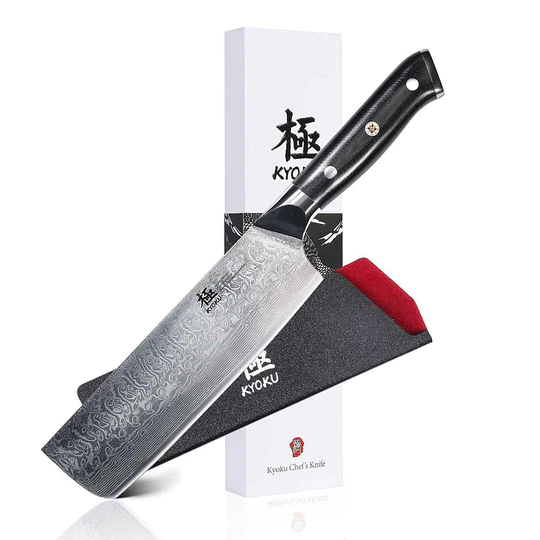


In the demanding world of aviation, where split-second decisions can be the line between life and death, every piece of gear must serve its purpose efficiently and reliably. Survival knives are among these critical tools. These knives stands out as emblems of preparedness and resilience.
But what exactly is a survival knife? At its core, a survival knife is a versatile tool designed to assist in emergency situations, whether it’s to cut through tangled parachute lines, build a shelter, or even signal for help. Drawing from both historic practices and contemporary needs, these knives have evolved over the years, fusing functionality with durability.
As a military pilot, I’ve come to understand and respect the true worth of a well-crafted survival knife, not just as a weapon, but as an indispensable ally when faced with the unpredictable challenges of the wild and hostile terrains.
Join me as we delve deeper into the world of survival knives, their features, applications, and the crucial role they play in a pilot’s survival kit.
For aviators, the history of survival knives finds its roots in the World Wars. Military pilots, facing the dire possibility of crash landing in enemy territory or rugged, uninhabited landscapes, required a multifunctional tool that could aid in both defense and survival after a forced landing.
The design of these knives evolved with specific modifications suitable for pilot needs, like saw edges to cut through aircraft fuselages or clear dense vegetation. By the time of the Vietnam War, survival knives became a standard issue for pilots, recognizing their value in the hostile terrains of the Southeast Asian jungles.
Today, these blades are an amalgamation of centuries of evolution, combining ancient reliability with modern-day innovation, making them indispensable for any military aviator and survival enthusiast, and something I would put as much emphasis on as a flight helmet.

In the adrenaline-pumping moments following an aviation emergency, a pilot’s actions and the tools at their disposal can mean the difference between life and death.
At the forefront of these life-saving tools is the survival knife, a tool for:
During Egress and Extraction, this knife proves invaluable. When a damaged aircraft entraps a pilot, the ability to swiftly cut through harnesses, belts, and other obstructions can be the key to a timely escape. Once safely on the ground, survival becomes the immediate objective.
In the unpredictable landscapes pilots might find themselves, the dual role of a survival knife as a tool and a weapon is paramount. For Self-Defense, its sturdy build and sharp edge serve as a formidable deterrent against both wild animals and potential human threats. The knife’s design, often featuring a pointed tip and serrated edge, can be wielded effectively to fend off or incapacitate threats, giving a downed pilot the chance to retreat to safety.
In colder environments or when night falls, the first priority is warmth. Using the survival knife in conjunction with flints or other fire-starting tools facilitates the essential task of Fire Starting.
Beyond this, Shelter Building becomes paramount. A good survival knife can assist in cutting and shaping materials, such as branches or foliage, to create an improvised protective shelter against harsh elements.
A survival knife can also be used to create extra wind breaks to protect basic bush craft shelters and lightweight tents.
Lastly, signaling for rescue is crucial. The polished blade of a survival knife can be angled to catch sunlight, providing a reflective surface for Signaling. Alternatively, by striking the knife against certain materials, it’s possible to create sound signals, alerting nearby rescuers.
Beyond defense, survival often hinges on sustenance. Hunting with a survival knife requires skill, but it can be a game-changer. While not as efficient as some other hunting weapons, a knife can be used to make an improved spear by either sharpening a stick or fixing the knife to the end, and when well-thrown, can take down small game or fish.
Additionally, the blade’s sharpness is essential for skinning, cleaning, and preparing caught game, ensuring a pilot stranded in the wilderness can secure vital nourishment until rescue arrives. Knives can also be used to help craft traps and snares.
In the challenging aftermath of an aviation mishap, the survival knife, with its multifaceted applications, can truly be a pilot’s best ally.
Even the most expertly crafted survival knife is only as reliable as the care it receives. For a tool that might one day be a lifeline, routine maintenance is not just advisable—it’s imperative.
Firstly, always keep the blade clean; after use, especially if it’s been in contact with corrosive materials like saltwater or acidic substances, wash it with fresh water and dry thoroughly. A thin layer of oil applied to the blade can prevent rust and maintain its sharpness.
Sharpening is another vital aspect; a dull blade can be more dangerous than a sharp one, leading to mishandling or accidents. Using a honing stone or a knife sharpener, maintain a consistent angle, ensuring the edge remains keen.
The knife’s handle, often overlooked, should also be checked for any wear or damage. If it’s made of wood, occasional oiling can prevent it from drying out or cracking. Lastly, when storing, ensure the knife is in a dry environment, preferably in a sheath that protects the blade while allowing air circulation.
With conscientious care, your survival knife will always be at its peak performance, ready for any situation a military pilot might confront.
When it comes to survival knives, especially for military pilots, functionality often takes center stage. However, it’s equally essential to be well-versed with the legalities surrounding their possession and use. Different countries, and even states within countries, have varying regulations pertaining to knife length, type, and purpose of use.
For instance, certain jurisdictions might restrict the carrying of fixed-blade knives, while others might have specific length limitations. Military pilots traveling or stationed internationally should be particularly cautious, ensuring they are compliant with local laws.
On the home front, while military personnel often have allowances for equipment deemed necessary for their roles, it’s prudent to understand any base-specific or branch-specific regulations. Additionally, while in civilian settings, such as airports, even off-duty military personnel or professional pilots might face scrutiny.
Always consider the legal ramifications when transporting, displaying, or using a survival knife, ensuring that safety and compliance go hand in hand.

The effectiveness of a survival knife as a crucial tool in emergency scenarios is undisputed. However, its potential for harm when misused underscores the need for diligent safety measures.
First and foremost, always handle the knife with respect, recognizing its sharpness and potential to inflict injury. When not in use, it should be securely stored in its sheath to avoid accidental cuts. When using the knife, always cut away from your body, ensuring hands and other body parts are clear of the blade’s path.
Proper grip is essential: hold the handle firmly and avoid placing fingers on the blade, even if it has a finger guard. When passing the knife to another person, offer the handle, not the blade.
Furthermore, avoid using the knife when fatigued or under the influence of substances that might impair judgment. This is critically important in survival situations where you are naturally not at your peak and will be fatigued – do not take any risks!
In wet or slippery conditions, extra care is necessary to prevent the knife from slipping out of hand. Remember, the survival knife’s primary role is to aid, not harm. Proper handling and awareness are vital in ensuring it serves its purpose without causing unintended injuries.
Survival knives, tailored for resilience and versatility, embody specific features that distinguish them from standard knives.
For starters, the blade is typically crafted from high-carbon steel or stainless steel, ensuring longevity and resistance to corrosion. Its length generally ranges between 4 to 6 inches, balancing ease of handling with efficacy. Full tang construction, where the blade material extends throughout the handle, is a hallmark of sturdiness, preventing breakage during strenuous tasks.
The blade’s edge might be a straight, serrated, or a combination of both, catering to various uses from precise cuts to sawing. The spine, or the knife’s back, is often flat and thick, suitable for striking and hammering.
An ergonomically designed handle made of durable materials like hard rubber, bone, or dense wood offers a secure grip. Many survival knives also feature a pommel or butt at the handle’s end, which can serve as an improvised hammer.
Added functionalities such as fire-starting notches, lanyard holes, and hollow handles for storage of small essentials further amplify their utility.
These thoughtfully integrated features are what make survival knives the quintessential companion for those navigating unpredictable and challenging environments.
The sheer adaptability and resilience of survival knives have made them indispensable tools, not just for military pilots, but for anyone venturing into the great unknown. From their storied history, stemming from primal needs, to their current status as a must-have in emergency kits, these knives embody the spirit of survival and preparedness.
For a military pilot, equipped with an arsenal of knowledge and expertise, the survival knife stands out not as a mere tool, but as a symbol of their readiness to face and overcome any challenge. As with any tool of such importance, understanding its features, safe handling, maintenance, and the accompanying legalities ensures its maximum potential is realized.
When wielded wisely, a survival knife is more than just a piece of metal; it’s a lifeline, a protector, and an emblem of the enduring human spirit to survive and thrive against all odds. Whether you’re soaring in the skies or trekking through wilderness terrains, let the survival knife serve as a reminder of mankind’s innate capability to adapt, improvise, and persevere.
Ken Johnson is the founder of ProAviationTips and has been flying for more than half of his life. Ken is an ex-military tactical airlift pilot who spent the most of his time flying the C-130-J-30 Super Hercules. In his spare time he loves getting out amongst GA and flying aerobatics, formation and instructional sorties, as well as writing about aviation and mentoring his students.

Knife Buzz offers independent product reviews on a wide range of knives used in the kitchen, home, and outdoors. We make it easy for you to find the right knife at the best price.

Knife Buzz offers independent product reviews on a wide range of knives used in the kitchen, home, outdoors and at work.
The Knife Buzz Team are passionate about reviewing knives and we cater to a targeted audience that needs independent advice before purchasing.
KnifeBuzz.com may earn affiliate commissions on some pages of this website. Knife Buzz is a participant in the Amazon Services LLC Associates Program, an affiliate advertising program designed to provide a means for sites to earn advertising fees by advertising and linking to Amazon.com. Amazon and the Amazon logo are trademarks of Amazon.com, Inc, or its affiliates. When you click links to various merchants on this site and make a purchase, this can result in this site earning a commission. Other affiliate programs and affiliations include, but are not limited to, Google AdSense.